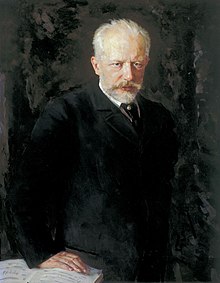1812 Overture
The 1812 Overture (French: Ouverture solennelle "L'Année 1812"; Russian: Торжественная увертюра 1812 года, Toržestvennaja uvertjura 1812 goda) (Op. 49) is an orchestral work by Pyotr Ilyich Tchaikovsky. It commemorates Russia's 1812 defense against Napoleon's advancing Grande Armée at the Battle of Borodino, during the French invasion of Russia.

The Overture's first public performance occurred on 20 August 1882 (NS; the OS date was 8 August). The venue was the Cathedral of Christ the Saviour in Moscow. The overture is best known for its climactic volley of cannon fire and ringing chimes.
Instrumentation
changeThe 1812 Overture is written for an orchestra which uses the following musical instruments:[1]
- Percussion
- Timpani
- Bass Drum
- Snare Drum
- Cymbals
- Tambourine
- Triangle
- Carillon (sometimes substituted with tubular bells or recordings of carillons, or even church bells)
- Cannon
Musical structure
changeSixteen cannon shots are written into the score of the Overture. The Overture begins with the plaintive Russian Orthodox Troparion of the Holy Cross ("God Preserve Thy People") played by eight cellos and four violas. The piece moves through a mixture of pastoral and militant themes. The Overture includes the Russian folk dance "At the Gate, at my Gate."[2] At the turning point of the invasion – the Battle of Borodino – the score calls for five Russian cannon shots. A descending string passage represents the following retreat of the French forces, followed by victory bells and a triumphant repetition of God Preserve Thy People as Moscow burns to deny winter quarters to the French. A musical chase scene appears. Out of it, the anthem "God Save the Tsar!" appears. The overture uses counterpoint to reinforce the appearance of the leitmotif that represents the Russian forces throughout the song.[3]
Although God Save The Tsar! was the Russian National Anthem in Tchaikovsky's time, it was not the anthem in 1812. There was no official Russian anthem until 1815.
There are several recordings of the overture in a transcription by American conductor Igor Buketoff,[4] with the following changes and additions:
- The opening segment, "God Preserve Thy People" is sung a cappella by a choir.
- A children's or women's choir added to the flute and cor anglais duet rendition of "At the Gate".
- The orchestra and chorus unite in the climax with a triumphant version of "God Preserve Thy People" and "God Save the Tsar".
Recording History
changeAntal Doráti's 1954 Mercury Records recording with the Minneapolis Symphony Orchestra, partially recorded at West Point and using the Yale Memorial Carillon in New Haven, Connecticut, uses a Napoleonic French single muzzleloading cannon shot on December 4, 1954 dubbed in 16 times as written. On the first edition of the recording, one side played the Overture and the other side played a narrative by Deems Taylor about how the cannon and bell effects were accomplished. (Later editions placed the commentary after the performance on side 1 and the Capriccio Italien on side 2.) A stereophonic album version was recorded on 4 December 1958, using the bells of the L.S. Rockefeller Carillon, at Riverside Church. On this Mercury Living Presence Stereo recording, the spoken commentary was also given by Deems Taylor and the 1812 was coupled with Tchaikovsky's Capriccio Italien.
The Berlin Philharmonic Orchestra conducted by Herbert Von Karajan, and the Don Cossacks Choir recorded the piece in 1967.
In 1971, CBS released a recording with the Philadelphia Orchestra conducted by Eugene Ormandy, also featuring the Mormon Tabernacle Choir, the Valley Forge Military Academy band and real artillery shots. Neeme Järvi's recording with the Gothenburg Symphony Orchestra, Gothenburg Artillery Division, Gothenburg Symphony Brass Band, Churchbells of Gothenburg & Gothenburg Symphony Chorus, was recorded on December 4, 1991, with his Marche Slave, Alexander Borodin’s In the Steppes of Central Asia and Prince Igor: Polovtsian Dances, and Nikolai Rimsky-Korsakov’s Russian Easter Festival Overture and Capriccio Espagnol. The first digital recording of the 1812 Overture is performed by Leonard Bernstein and the New York Philharmonic Orchestra in 1975. The last digital recording is by Erich Kunzel, the Cincinnati Pops, and the Kiev Symphony Chorus in 2001.
In 1990, during a worldwide celebration of the 150th anniversary of Tchaikovsky's birth, the Overture was recorded in the city of his youth by the Tchaikovsky Symphony Orchestra, also known as the All-Union Radio and Television Symphony and Philharmonic Orchestra, using 16 muzzleloading cannons fired live as written in the 1880 score. In June 2009, the record soon became a most popular complete orchestral record with fireworks at the finale.
References
change- ↑ Tchaikovsky, Piotr Ilyich (1996). 1812 overture: Marche slave, and ; Francesca da Rimini. Courier Dover Publications. ISBN 978-0-486-29069-0. Retrieved 29 December 2009.
- ↑ "University of Texas: Lecture slides" (PDF). University of Texas. Archived from the original (PDF) on 16 February 2008. Retrieved 1 January 2009.
- ↑ Tchaikovsky's 1812: The Multimedia Festival Overture. Future Vision Multimedia. Nanuet, NY, 1994.
- ↑ See: http://web.singnet.com.sg/~lionelc/nov97.htm Archived 2008-12-04 at the Wayback Machine
Other websites
change- Article from 2003 Pittsburgh Post-Gazette on how “1812” has become a piece of patriotic Americana Archived 2008-06-10 at the Wayback Machine
- Russian national anthem “God Save the Tsar” in Tchaikovsky’s music Archived 2006-07-10 at the Wayback Machine — contains several audio recordings of the 1812 Overture.
- Interview with J. Paul Barnett about the 1812 Overture by Bruce Duffie, 20 November 1999